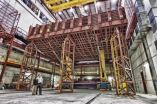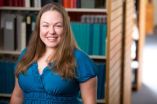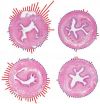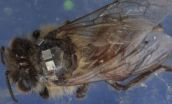(Press-News.org) Today, technicians in Minnesota will begin to position the first block of a detector that will be part of the largest, most advanced neutrino experiment in North America.
The NuMI Off-Axis Neutrino Appearance experiment – NOvA for short – will study the properties of neutrinos, such as their masses, and investigate whether they helped give matter an edge over antimatter after both were created in equal amounts in the big bang. The experiment is on track to begin taking data in 2013.
"This is a significant step toward a greater understanding of neutrinos," said Marvin Marshak, NOvA laboratory director and director of undergraduate research at the University of Minnesota. "It represents many months of hard work on the part of the whole NOvA collaboration."
Neutrinos are elementary particles, basic building blocks of matter in the Standard Model of particle physics. They are almost massless, and they interact so rarely with other matter that they can move straight through hundreds of miles of solid rock.
The NOvA experiment will study a beam of neutrinos streaming about 500 miles through the Earth from the U.S. Department of Energy's Fermi National Accelerator Laboratory near Chicago to a large detector in Ash River, Minnesota. The particles, generated in what will be the most powerful neutrino beam in the world, will make the trip in less than three milliseconds.
Today, crews will use a 750,000-pound pivoter machine to lift the first 417,000-pound block – one of 28 that will make up the detector – and put it in place at the end of the 300-foot-long detector hall. The delicate process may take multiple days.
Each block of the detector measures 51 by 51 by 7 feet and is made up of 384 plastic PVC modules. About 170 students from the University of Minnesota built the modules, stringing them with optical fibers and attaching their endcaps.
Scientists and engineers at the Department of Energy's Argonne National Laboratory developed the machine that glues modules into blocks. Scientists and engineers at Fermilab developed the pivoter machine and assembly table.
"About a dozen scientists, engineers and technicians from Fermilab and Argonne have been up to Ash River multiple times in the past year to make this thing happen," said Rick Tesarek, Fermilab physicist and NOvA deputy project leader. "They're part of a team of over a hundred collaborators who have been actively working on the experiment."
Once the block is installed, crews will fill it with liquid scintillator. When neutrinos interact with the liquid, they will produce charged particles that will release light, which the optical fiber will detect. The fiber will carry the signal to electronics, which will record the neutrino event.
Neutrinos come in three flavors, each associated with a different elementary particle: electron, muon and tau. Three different types of neutrinos oscillate between these flavors, spending a different fraction of their lives as each flavor.
"Everyone's been watching to see which experiment will make the next big step in uncovering the properties of neutrinos," said Mark Messier, Indiana University physicist and co-spokesperson of the NOvA experiment. "The NOvA experiment should be it. It is uniquely positioned to be the first experiment to determine the ordering of the masses of the three neutrinos."
Officials first broke ground on the NOvA detector facility, a laboratory of the University of Minnesota's School of Physics and Astronomy, in May 2009. Crews completed the building this spring.
The experiment will use two detectors, a 330-metric-ton near detector at Fermilab and the 14-kiloton far detector at the detector facility close to the U.S.-Canadian border, to look for changes in the neutrino beam as it travels. The far detector is scheduled to begin taking data in 2013 and to be completed in early 2014.
An upgrade of the Fermilab neutrino beam, now in progress during a yearlong accelerator shutdown, will be crucial to the experiment. Fermilab will increase the power of the beam by a factor of two from 320 kilowatts to 700 kilowatts. NOvA experimenters expect eventually to study asample of about 100 neutrino events collected during six years of operation.
The NOvA experiment is a collaboration of 169 scientists from 19 universities and laboratories in the U.S and another 15 institutions around the world.
INFORMATION:
Fermilab is America's premier national laboratory for particle physics research. A U.S. Department of Energy Office of Science laboratory, Fermilab is located near Chicago, Illinois, and operated under contract by the Fermi Research Alliance, LLC. Visit Fermilab's website at http://www.fnal.gov and follow us on Twitter at @FermilabToday.
The DOE Office of Science is the single largest supporter of basic research in the physical sciences in the United States, and is working to address some of the most pressing challenges of our time. For more information, please visit http://science.energy.gov.
Additional Information:
NOvA website: http://www-nova.fnal.gov/
NOvA: Exploring Neutrino Mysteries [video]: http://www.symmetrymagazine.org/article/may-2005/explain-it-in-60-seconds
Crews complete first block of North America's most advanced neutrino experiment
2012-09-07
ELSE PRESS RELEASES FROM THIS DATE:
ORNL's newly licensed neutron detector will advance human disease research
2012-09-07
A neutron detector developed for studies focused on life science, drug discovery and materials technology has been licensed by PartTec Ltd. The Indiana-based manufacturer of radiation detection technologies is moving the technology developed at the U.S. Department of Energy's Oak Ridge National Laboratory toward the commercial marketplace.
The Neutron-Sensitive Anger Camera allows researchers to study a wider variety of crystalline structures, supporting studies in biology, earth science, geology, materials science and condensed matter physics.
"This ORNL detector system, ...
Favorite TV reruns may have restorative powers, says UB researcher
2012-09-07
BUFFALO, N.Y. -- We hear all the time that we need to get off the couch, stop watching TV and get moving.
But what if watching TV under specific conditions could actually provide the mental boost you need to tackle a difficult task?
A new paper that describes two studies by Jaye Derrick, PhD, research scientist at the University at Buffalo's Research Institute on Addictions, found that watching a rerun of a favorite TV show may help restore the drive to get things done in people who have used up their reserves of willpower or self-control.
"People have a limited pool ...
September 2012 story tips
2012-09-07
ENERGY – Revolutionary heat pump . . .
Oak Ridge National Laboratory and Oklahoma's ClimateMaster Inc. have collaborated to develop a ground source heat pump that can reduce a homeowner's electric bill by up to 60 percent. The Trilogy 40 is the first geothermal heat pump certified by the Air Conditioning, Heating and Refrigeration Institute to achieve a space cooling efficiency rating in excess of 40 EER (energy efficiency ratio). An EER rating of 13.5 is typical of conventional heat pumps. For a family living in a 2,600-square-foot well-insulated home, that translates ...
Even small weight gains raise blood pressure in college students
2012-09-07
URBANA – As a college student, you may be happy simply not to have gained the "Freshman 15." But a University of Illinois study shows that as little as 1.5 pounds per year is enough to raise blood pressure in that age group, and the effect was worse for young women.
"In our study, a small weight gain was enough to raise a college student's systolic blood pressure by 3 to 5 points. If young people continue to gain 1.5 pounds a year and think it doesn't matter, they're misleading themselves and increasing their risk for heart disease," said Margarita Teran-Garcia, a U of ...
Alcoholics Anonymous participation promotes long-term recovery
2012-09-07
A new study published in a special issue of Substance Abuse finds that recovering alcoholics who help others in 12-step programs furthers their time sober, consideration for others, step-work, and long-term meeting attendance.
These novel findings are from a 10-year, prospective investigation led by Maria Pagano, PhD, associate professor of psychiatry at Case Western Reserve University School of Medicine and principal investigator of the "Helping Others" study. Dr. Pagano and colleagues evaluated the decade long of treatment outcomes using data from a single site in ...
Modeling sepsis in newborns
2012-09-07
Boston, Mass. - Sepsis, or bacterial infection of the bloodstream, is a grave, hard-to-diagnose threat in premature newborns in the NICU. Even when it's detected and treated with antibiotics, its inflammatory effects can harm fragile babies' development. Now, researchers at Boston Children's Hospital have modeled the effects of sepsis on the unique newborn immune system, using mice. They and others have begun using the model to identify diagnostic markers and better treatments.
The new model is described September 6 in the online open-access journal PLOS ONE (available ...
Biopsies may overlook esophagus disease
2012-09-07
SALT LAKE CITY Sept. 6, 2012 - University of Utah engineers mapped white blood cells called eonsinophils and showed an existing diagnostic method may overlook an elusive digestive disorder that causes swelling in the esophagus and painful swallowing.
By pinpointing the location and density of eosinophils, which regulate allergy mechanisms in the immune system, these researchers suggest the disease eosinophilic esophagitis, or EoE, may be under- or misdiagnosed in patients using the current method, which is to take tissue samples (biopsies) with an endoscope.
These ...
SF State biologists tag 'zombees' to track their flight
2012-09-07
SAN FRANCISCO, Sept. 6, 2012 -- After last year's accidental discovery of "zombie"-like bees infected with a fly parasite, SF State researchers are conducting an elaborate experiment to learn more about the plight of the honey bees.
The scientists are tagging infected bees with tiny radio trackers, and monitoring the bees' movements in and out of a specially designed hive on top of the Hensill Hall biology building on campus. At the same time, they are monitoring hives on campus and on the roof of the San Francisco Chronicle's offices for further signs of the mysterious ...
Well-known protein reveals new tricks
2012-09-07
A protein called "clathrin," which is found in every human cell and plays a critical role in transporting materials within them, also plays a key role in cell division, according to new research at the University of California, San Francisco.
The discovery, featured on the cover of the Journal of Cell Biology in August, sheds light on the process of cell division and provides a new angle for understanding cancer. Without clathrin, cells divide erratically and unevenly—a phenomenon that is one of the hallmarks of the disease.
"Clathrin is doing more than we thought ...
Even the very elderly and frail can benefit from exercise
2012-09-07
A study carried out by Dr. Louis Bherer, PhD (Psychology), Laboratory Director and Researcher at the Institut universitaire de gériatrie de Montréal (IUGM), an institution affiliated with Université de Montréal, has shown that all seniors, even those considered frail, can enjoy the benefits of exercise in terms of their physical and cognitive faculties and quality of life and that these benefits appear after only three months.
This discovery is excellent news, as increased life expectancy has also increased the number of frail seniors in our communities. In geriatrics, ...




